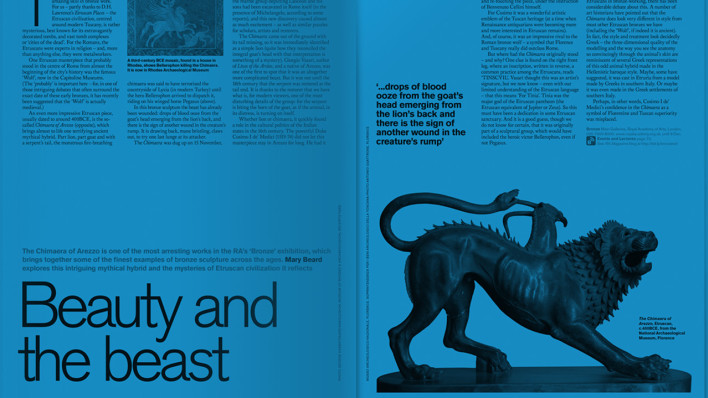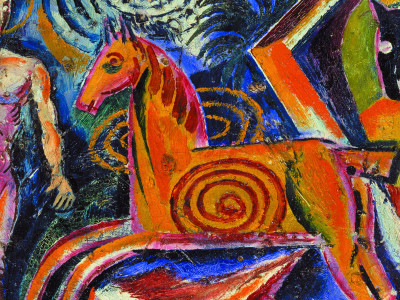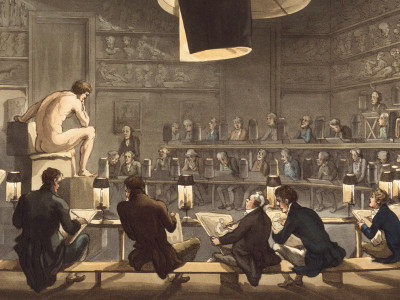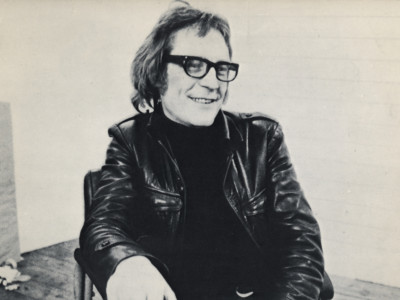
A brush with genius: Barry Humphries on sitting for David Hockney RA
By Barry Humphries
Published on 14 June 2016
David Hockney RA returns to the Academy this summer with his sparkling new series of portraits. Barry Humphries, creator of Dame Edna Everage and friend of the artist, recounts his experience of sitting for a portrait in Hockney's Los Angeles studio.
From the Summer 2016 issue of RA Magazine, issued quarterly to Friends of the RA.
David Hockney has drawn me twice and painted my portrait once – the painting goes on show at the Royal Academy this summer together with his other recent portraits. Last year I was performing one of my innumerable farewell shows in a seven-week season in Los Angeles, so I found that I could visit my artist friend on several occasions. On one of these he said he’d like to paint me.
I have known David for a long time but he was a particularly close friend of my late father-in-law Stephen Spender, with whom he collaborated on China Diary (1982): a record in words and pictures of their visit to China in the early 1980s. But David had been a friend of the family long before that book and he even designed the invitation to my wife Lizzie Spender’s 21st birthday. David made paintings and drawings of many of the poets and writers who had come to fame in the 1930s, notably Auden and Isherwood, as well as Spender. He loves to draw people, and in this art he exceeds the work of all his contemporaries.
So it was, one morning in early March last year, having cancelled a trip to New York, I set off from my favourite Beverly Hills hotel for my first sitting in David’s studio way up on Mulholland Drive. My preferred accommodation is a rather modest affair and was recommended to me by Billy Wilder, whom I first met at David’s place in Malibu about 20 years ago. The hotel was, and still is, a ’70s time-warp with a Hockney-like swimming pool beside which only the most obscure movie stars have ever reclined. David has not only immortalised Los Angeles, but forever changed the way we look at swimming pools.
After he moved to Los Angeles in 1978, David’s first studio was on Santa Monica Boulevard. He commuted up and down Nichols Canyon from his house on Mulholland Drive, painting the canyon, as well as making his famous full-length ‘portrait’ of Mulholland Drive (pictured below). Hockney built a studio at his home in 1982 after he bought the adjacent house from the actor Tony Perkins (whom he never met). Everyone in Los Angeles – or that end of it – lives in a house that belonged to someone else. For a long time I rented a rambling old farmhouse with its own lemon grove and colony of rats that had formerly belonged to the film star Myrna Loy. And I once nearly bought a modernist villa in Los Feliz where that forgotten crooner and heartthrob of the early ’30s, Russ Columbo, had been fatally shot under mysterious circumstances.

On that morning in March I found myself seated in a comfortable wooden chair with armrests in Hockney’s studio. The chair was set on a dais and below me to the left stood David at his easel, brush poised over a 22 by 91cm virgin canvas and a shrewd eye tilted inquisitively in my direction. That morning I had deliberately dressed in Hockney colours, as fortunately I have come to prefer brighter, even slightly gaudy habiliments. Arranged around the walls of the studio were many of his other subjects, mostly friends, male and female, all posed in the same chair and painted directly and without emotion(see portraits below). These diverse personages all look as if they might suffer from elevated blood pressure, since David imparts to his subjects ruddy complexion.
Throughout each sitting we were filmed by his assistant Jean-Pierre, a charming Frenchman and devotee of the artist, and there is a filmed record of every portrait, so that the movement of the artist’s brush can be seen on a screen at every stage of the creation, from blank canvas to completed painting. Hockney is as much a looker as a painter and the intensity of his scrutiny as it switched from brushstroke to me, seated as still as I could manage, was rather awe-inspiring. In this age where it is possible to call yourself an artist without being able to draw, David Hockney is a rare phenomenon.
Throughout the process he smoked – there was usually a nourishing cigarette in his left hand. And although he is an energetic and always entertaining talker, he rarely spoke when painting. Sometimes he gave a short grunt of satisfaction or looked up at his subject with a smile that told me it was going well.
David Hockney painted Barry Humphries' portrait over three days, between 26 and 28 March 2015.
I was able to give him three sittings, though some of his other subjects have only offered the artist two. We broke for lunch at 1pm or 1.30pm and adjourned to the house for a very good Californian lunch, where there was much talk and laughter. David’s table talk really should be recorded and published because his enthusiasms are always impassioned and infectious. He explained the critical neglect of Dufy and Marquet in comparison with the disproportionate hyperbole heaped on Matisse. He survived a disabling stroke in October 2012 and he is very deaf, so avoids noisy crowds but can still engage in a lively conversation across the dinner table. When he came to my show I practically sat him on the stage and made sure my body language was as loud as possible.
I first saw and briefly met David in the late ’70s in New York at that legendary nightclub Studio 54, where one sometimes glimpsed the ghostly figure of Andy Warhol loitering in the shadows beside the hectic dance floor. Some time in that same decade I sat to the photographer Cecil Beaton for my portrait and he never stopped talking about Hockney and Nureyev, who seemed to have replaced even Greta Garbo as the objects of his affection and admiration.

Rufus Hale, 23rd, 24th, 25th November 2015 , 2015

Margaret Hockney, 14th, 15th, 16th August 2015, 2015

John Baldessari, 13th, 16th December 2013 , 2013

Dagny Corcoran, 15th, 16th, 17th January 2014 , 2015
David was the child prodigy of British art but unlike many child prodigies he didn’t fizzle out. His work has broadened and deepened and when he paints your portrait and occasionally speaks to you in that soft Yorkshire accent, which reminds me of the voice of my Lancastrian grandfather, you find yourself hoping not that the picture will look like you, but that you, with any luck, will look like the picture.
Some years ago, the Los Angeles County Museum staged a recreation of the Nazis’infamous ‘Degenerate Art’ exhibition. Many of the original paintings and drawings that had been held to ridicule in 1937 had, surprisingly, not been destroyed, but prudently flogged in Switzerland to raise cash for the Reich. ‘How extraordinary,’ I said to David, ‘that so many fragile works had survived the bibliocausts of that terrible epoch.’
‘Why?’ I asked my friend. ‘Because somebody loved them,’ replied Hockney. By the same principle it is reassuring to think of the afterlife of my own portrait. Does it deserve to be an object only to be enjoyed and cherished by a solitary collector? Or ought it to be the venerated centrepiece of a large and distinguished museum, reproduced on postcards, T-shirts and oven mitts in the gallery boutique?
Sometimes on stage I might improvise something rather successful and my other self standing in the wings says, ‘I wish I’d thought of that.’ It’s similar with my portrait by David. It’s not how I always look but how I rather wish I did.
In the studio with David Hockney RA
In his studio in LA, David Hockney discusses his upcoming exhibition with curator Edith Devaney.
Barry Humphries is an actor, comedian, producer and writer. Best known as the character Dame Edna Everage, Humphries has starred in many television series, films and West End musical theatre productions.
David Hockney RA: 82 Portraits and 1 Still-life is at The Sackler Wing, Royal Academy of Arts from 2 July – 2 October 2016.

Enjoyed this article?
As well as free entry to all of our exhibitions, Friends of the RA enjoy one of Britain’s most respected art magazines, delivered directly to your door. Why not join the club?
Related articles

Visions from Ukraine
19 June 2024

10 RA Schools stories through the centuries
16 May 2024

In memoriam: Mick Moon RA
1 May 2024



